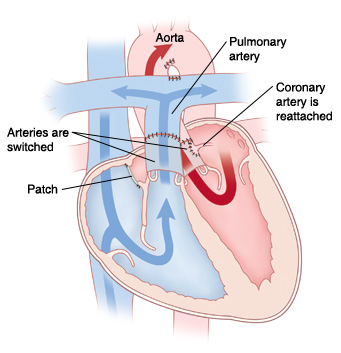Your Child's Transposition of the Great Arteries Surgery
Your Child's Transposition of the Great Arteries (TGA) Surgery
The surgery to repair TGA is known as an arterial switch operation. A pediatric heart surgeon performs the surgery. The surgery lasts about 4 to 6 hours. It takes place in an operating room in a hospital. You’ll stay in the waiting room during surgery.
Before surgery. You’ll be told to keep your child from eating or drinking anything for a certain amount of time before surgery. Follow these instructions carefully.
During surgery. Your child is given medicine (sedative or anesthesia) to help him or her sleep and not feel pain during surgery. A breathing tube is placed in your child’s trachea (windpipe). Special equipment monitors your child’s heart rate, blood pressure, and oxygen levels. The surgeon makes an incision in the chest through the breastbone (sternum) to reach the heart. Your child is placed on a heart-lung bypass machine. This allows blood to continue flowing to the body and lungs while the heart is stopped so that it can be operated on. The positions of the aorta and pulmonary artery are switched so that they’re connected to the correct ventricles (aorta connected to the left ventricle and pulmonary artery connected to the right ventricle). The blood vessels that supply blood to the heart (coronary arteries) are taken out of the aorta. They are reconnected to the aorta once it has been moved into its correct position. Then your child is taken off the bypass machine and the chest is closed.
After surgery. Your child is taken to a critical care unit to be cared for and monitored. You can stay with your child during much of this time. He or she may remain in the hospital for 2 weeks. When your child is ready to leave the hospital, you’ll be given instructions for home care.
Complications of heart surgery for TGA
Potential complications following the procedure include:
Stenosis of the main pulmonary arteries requiring further treatment
Stenosis of the coronary arteries
Dilation of blood vessels
Regurgitation of heart valves
Decline in heart function or pumping ability
Heart rhythm abnormalities
Developmental delay
Attention deficit hyperactivity disorder (ADHD)
Decreased psychosocial functioning
When to call the doctor
After heart surgery, call the doctor right away if your child has any of the following:
Increased redness, draining, swelling, or bleeding at the incision site
Fever 100.4°F (38°C) or higher, or as advised
Trouble feeding, poor appetite, or weight loss
Tiredness
Shortness of breath
Cough that won’t go away
Nausea or vomiting that continues
Irregular heartbeat
Flaring of the nostrils
Irritability
No noticeable improvement
What are the long-term concerns?
After repair of TGA, most children can be active. The level and extent of physical activity will vary with each child. Check with the cardiologist about what activities are appropriate for your child.
Your child will need regular follow-up visits with the cardiologist for the rest of your child's life. Sometimes the blood vessels to the lungs may become blocked over time. When this happens, your child may need a cardiac catheterization to reopen them.
Your child may need to take antibiotics before having any surgery or dental work for 6 months or longer after the surgery. This is to prevent infection of the inside lining of the heart and valves. This infection is called infective endocarditis. Antibiotics should be taken as directed by the cardiologist.
Updated:
August 17, 2018
Sources:
Management and outcome of D transposition of the great arteries, Up To Date, Pathophysiology, clinical manifestations, and diagnosis of D-transposition of the great arteries, UpToDate
Reviewed By:
Ayden, Scott, MD,Bass, Pat F. III, MD, MPH,Image reviewed by StayWell medical illustration team.
